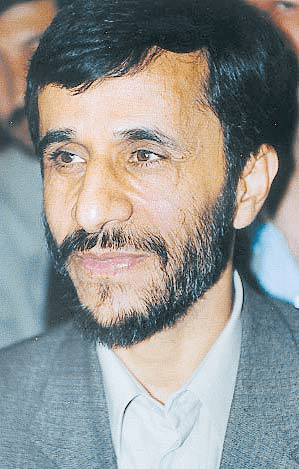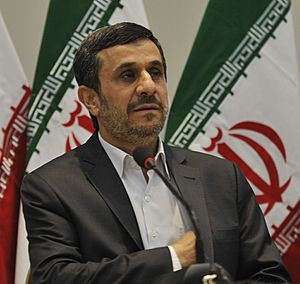Mahmoud Ahmadinejad facts for kids
Quick facts for kids
Mahmoud Ahmadinejad
|
|||||||||||||||||||||||||
|---|---|---|---|---|---|---|---|---|---|---|---|---|---|---|---|---|---|---|---|---|---|---|---|---|---|
|
محمود احمدینژاد
|
|||||||||||||||||||||||||

Ahmadinejad in 2019
|
|||||||||||||||||||||||||
| Member of Expediency Discernment Council | |||||||||||||||||||||||||
| Assumed office 5 August 2013 |
|||||||||||||||||||||||||
| Appointed by | Ali Khamenei | ||||||||||||||||||||||||
| Chairman | Akbar Hashemi Rafsanjani Ali Movahedi-Kermani (acting) Mahmoud Hashemi Shahroudi Sadeq Larijani |
||||||||||||||||||||||||
| Preceded by | Hassan Rouhani | ||||||||||||||||||||||||
| 6th President of Iran | |||||||||||||||||||||||||
| In office 3 August 2005 – 3 August 2013 |
|||||||||||||||||||||||||
| Supreme Leader | Ali Khamenei | ||||||||||||||||||||||||
| Vice President | Mohammad Reza Aref Parviz Davoodi Esfandiar Rahim Mashaei Mohammad Reza Rahimi |
||||||||||||||||||||||||
| Preceded by | Mohammad Khatami | ||||||||||||||||||||||||
| Succeeded by | Hassan Rouhani | ||||||||||||||||||||||||
|
|||||||||||||||||||||||||
| 42nd Mayor of Tehran | |||||||||||||||||||||||||
| In office 20 May 2003 – 28 June 2005 |
|||||||||||||||||||||||||
| Preceded by | Mohammad-Hossein Moghimi (acting) | ||||||||||||||||||||||||
| Succeeded by | Ali Saeedlou (acting) | ||||||||||||||||||||||||
| 1st Governor General of Ardabil | |||||||||||||||||||||||||
| In office 28 November 1993 – 29 October 1997 |
|||||||||||||||||||||||||
| President | Akbar Hashemi Rafsanjani | ||||||||||||||||||||||||
| Preceded by | Province created | ||||||||||||||||||||||||
| Succeeded by | Seyyed Hamid Tahayi | ||||||||||||||||||||||||
| Secretary-General of the Non-Aligned Movement | |||||||||||||||||||||||||
| In office 30 August 2012 – 3 August 2013 |
|||||||||||||||||||||||||
| Preceded by | Mohamed Morsi | ||||||||||||||||||||||||
| Succeeded by | Hassan Rouhani | ||||||||||||||||||||||||
| Personal details | |||||||||||||||||||||||||
| Born |
Mahmoud Sabbaghian
28 October 1956 Aradan, Imperial State of Iran |
||||||||||||||||||||||||
| Political party |
|
||||||||||||||||||||||||
| Other political affiliations |
|
||||||||||||||||||||||||
| Spouse |
Azam al-Sadat Farahi
(m. 1980) |
||||||||||||||||||||||||
| Children | 3 | ||||||||||||||||||||||||
| Relatives |
|
||||||||||||||||||||||||
| Residences | Square 72, Narmak, Tehran | ||||||||||||||||||||||||
| Alma mater | Iran University of Science and Technology (BS, PhD) | ||||||||||||||||||||||||
| Occupation | University professor | ||||||||||||||||||||||||
| Profession | Engineer | ||||||||||||||||||||||||
| Military service | |||||||||||||||||||||||||
| Allegiance | |||||||||||||||||||||||||
| Branch/service | |||||||||||||||||||||||||
| Years of service | 1986–1988 | ||||||||||||||||||||||||
| Rank | None | ||||||||||||||||||||||||
| Unit | Hamzeh Headquarters | ||||||||||||||||||||||||
| Commands | Combat engineering Unit, 6th Special Division | ||||||||||||||||||||||||
| Battles/wars |
|
||||||||||||||||||||||||
| Scientific career | |||||||||||||||||||||||||
| Institutions | Iran University of Science and Technology | ||||||||||||||||||||||||
| Theses |
|
||||||||||||||||||||||||
| Doctoral advisor | Hamid Behbahani | ||||||||||||||||||||||||
| Other academic advisors | Ali Mansour Khaki Gholamreza Shirazian Jalil Shahi |
||||||||||||||||||||||||
Mahmoud Ahmadinejad (born October 28, 1956) is an Iranian politician who was the sixth president of Iran from 2005 to 2013. He is known for his conservative political views and strong support for Iran's nuclear programme.
Before becoming president, Ahmadinejad was the mayor of Tehran, Iran's capital city, from 2003 to 2005. As an engineer and teacher who grew up in a poor family, his political ideas were shaped by the Iranian Revolution.
During his time as president, Ahmadinejad was a well-known but often criticized leader. In Iran, some people disagreed with his economic plans. Outside of Iran, he was known for his strong disagreements with countries like Israel and the United States. He was re-elected in 2009, but the results were disputed, leading to large protests.
After his presidency, he was not allowed to run again in 2017, 2021, and 2024. He is currently a member of a government group called the Expediency Discernment Council.
Contents
A Look at His Early Life
Mahmoud Ahmadinejad was born in the village of Aradan, near Garmsar, Iran. His father, Ahmad, was a barber and a religious Shia Muslim. When Mahmoud was one year old, his family moved to Tehran. His father changed the family's last name from "Sabbaghian" to "Ahmadinejad" to avoid problems in the new city.
In 1976, Ahmadinejad did very well on the national university entrance exam. He was ranked 132nd out of 400,000 students. He studied civil engineering at the Iran University of Science and Technology in Tehran. He later earned his PhD in transportation engineering from the same university in 1997.
Early Political Career
After the Islamic Revolution in 1979, Ahmadinejad became involved in politics. During the 1980s, he held several government jobs in different parts of Iran. He also served as a volunteer in the Islamic Revolutionary Guard Corps during the Iran-Iraq War.
In 1993, he was appointed governor of the newly created Ardabil Province. He held this position until 1997, when a new president, Mohammad Khatami, replaced him. After that, he went back to teaching at the university.
Mayor of Tehran (2003–2005)
In 2003, the city council of Tehran chose Ahmadinejad to be the city's mayor. As mayor, he made many changes that reflected his strong religious beliefs. For example, he separated elevators for men and women in city office buildings. He also focused on helping the poor by providing things like free soup.
He resigned as mayor in 2005 after he was elected president. During his time as mayor, he was nominated for the World Mayor award, which recognizes outstanding city leaders.
Presidency (2005–2013)
Ahmadinejad served two terms as the president of Iran. His presidency was marked by major changes in both domestic and foreign policy.
Presidential Elections
2005 Election
When Ahmadinejad first ran for president in 2005, he was not very famous. He used the slogan, "It's possible and we can do it." He presented himself as a man of the people, promising to use Iran's oil money to help the poor. He won the election with 62% of the vote in the final round.
2009 Election and Protests
Ahmadinejad ran for a second term in 2009 and won again. However, many people believed the election was unfair. This led to massive protests across Iran, known as the Green Movement. Despite the protests, Iran's Supreme Leader, Ali Khamenei, supported the results, and Ahmadinejad began his second term.
Domestic Policy
Ahmadinejad's policies at home focused on the economy, social issues, and the country's nuclear program.
Economic Plans
Ahmadinejad tried to help poor families by giving them financial support and keeping the price of gasoline low. However, his policies also led to some problems. For example, the cost of housing in cities went up, making it harder for young people to buy homes. Some economists criticized his government for its high spending.
Nuclear Program
Ahmadinejad was a strong supporter of Iran's nuclear program. He always said that the program was for peaceful purposes, like creating electricity. He stated that building a nuclear bomb was against Iran's religion and laws.
However, many Western countries, including the United States, were worried that Iran was secretly trying to build nuclear weapons. This disagreement led to international pressure and sanctions (penalties) against the country.
Human Rights and Universities
During his presidency, Ahmadinejad's government was criticized by international groups for its human rights record. There were also changes in the university system. Some older professors were forced to retire and were replaced by younger ones. This was sometimes called a "second cultural revolution."
Foreign Relations
Ahmadinejad's approach to foreign policy was very different from the presidents before him. He built stronger relationships with countries in Latin America and Africa. However, his relationships with Western countries, especially the United States and Israel, became very tense.
Disagreements with Israel
Ahmadinejad followed Iran's policy of not recognizing Israel as a country. In 2005, he made a controversial speech where he was translated as saying that Israel "must be wiped off the map." This caused a lot of anger around the world.
Later, some language experts argued that the translation was not accurate. They said his words meant something more like "the regime occupying Jerusalem must vanish from the page of time." Still, his comments were widely condemned. He was also criticized for making statements that questioned the history of the Holocaust.
Relationship with the United States
Relations with the United States were very difficult during Ahmadinejad's presidency. At the United Nations, he made speeches that were highly critical of the U.S. government. In 2010, he claimed that the U.S. government was behind the 9/11 attacks, which caused many world leaders to walk out of his speech in protest.
Life After the Presidency
After leaving office in 2013, Ahmadinejad returned to his private life and teaching at the university. He was appointed to the Expediency Discernment Council by the Supreme Leader.
He tried to run for president again in 2017, 2021, and 2024, but he was not allowed to by the Guardian Council, a group that approves candidates.
In 2022, he surprised many by expressing support for Ukraine during the Russian invasion. This was different from the official position of the Iranian government, which was more supportive of Russia.
Personal Life
Ahmadinejad is married and has two sons and one daughter. He is known for living a simple life. When he became president, he chose not to live in a fancy palace. He reportedly replaced expensive carpets in the presidential palace with cheaper ones and preferred to fly on cargo planes instead of a special presidential jet.
Images for kids
See also
 In Spanish: Mahmud Ahmadineyad para niños
In Spanish: Mahmud Ahmadineyad para niños
















